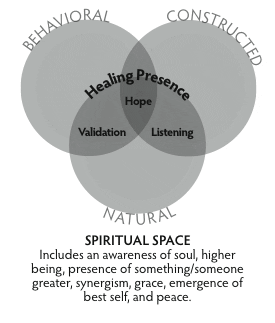“The aim of all spiritual paths, no matter their origin or the rigors of their practice, is to help us live more fully in the lives we are given. In this way, whatever comes from a moment’s grace that joins us to our lives and to each other – this is spiritual.” — Parker J. Palmer
We never know when the lens through which we see our roles as nurses will widen to reveal a new spark of possibility for caring and an opportunity
to deepen our spiritual awareness through this most remarkable profession. Even when we decide to leave the clinical setting or retire, we still remain “nurses” because in large measure, this is the essence of who we are called to be in this world.

Sometimes I have heard, “Oh, I could never be a nurse – it’s too ‘touchy-feely.’” I offer a different perspective in that we touch lives on many levels through our day-to-day work. In those same moments, we are also touched by our patients’ grace to help us see “from the inside out” a deeper side of humanity. This is personal knowing uniquely drawn from the well of our own life experiences and a silent reciprocal gifting between our patients and ourselves that is remembered.
This remembering is important, but the heart of this article calls for remembering as something quite different. “Re-membering” as defined by John Schneider, Ph.D, a clinical psychologist who taught and wrote extensively about the transformative potential of grief, is used “to bring back together the broken pieces of ourselves into a new wholeness. Those ‘members’ could be our minds, bodies, and spirits, often split apart. Re-membering is bringing us into a new ‘best self.’”
Consider for a moment that nursing is not mainstream. Certainly, healthcare’s medical advances in treatment and technology are in the mainstream to help us “do” what we must, but the “being” of our healing presence as nurses cannot be replicated, boxed, or sold in quantity. For many years, my personal, educational, and professional views on life have filtered through the lens of a human ecological perspective and primarily the influence of three environments, represented as complex circular dimensions of our behavioral patterns, how we construct our day-to-day lives, and our natural environment inclusive of the concepts time, space, and energy. These three environments are integrally related and perpetually influential, yet I found that existing ecological models did not truly articulate the interplay of our humanity for one another, person to person. I began searching for some connection that went deeper.
You see, in 1987 I began playing a folk harp as a way to temporarily distance myself from the emotional overload of intensive statewide hospice work while at the same time completing my doctoral requirements. Holding my small harp close to my heart and gently playing resonated deep within to replenish my own need for healing and wellness. As I began to play my harp at the bedside for patients, something profound and wordlessly palpable seemed to convey the vital missing touchstone I sought. In 1998, I named this the “spiritual space” at the core of the three circular dimensions mentioned above, the place where our healing presence whispers soul to soul through validation, listening, and hope.
Spiritual space – yours and theirs
 This spiritual space we are privileged to enter as we draw near to every patient is felt, not seen, and can include an awarenes of soul, a higher being, the presence of something/someone greater, synergism, grace, emergence of the best self, and peace. Every encounter with a patient is the experience of entering their spiritual space, no matter how brief the time we may spend with them. I ask you to consider whether you enter as a whirlwind of activity and tasks to complete or with quiet respect for your patient’s dignity in the moment. Do you hold eye contact? Is your healing presence patient with the patient?
This spiritual space we are privileged to enter as we draw near to every patient is felt, not seen, and can include an awarenes of soul, a higher being, the presence of something/someone greater, synergism, grace, emergence of the best self, and peace. Every encounter with a patient is the experience of entering their spiritual space, no matter how brief the time we may spend with them. I ask you to consider whether you enter as a whirlwind of activity and tasks to complete or with quiet respect for your patient’s dignity in the moment. Do you hold eye contact? Is your healing presence patient with the patient?
In his book A Hidden Wholeness, Parker J. Palmer writes, “Despite its toughness, the soul is also shy. The last thing we should do is go crashing through the woods yelling for it to come out.”
We must also reflect on what it means to be a healing presence within the spiritual space. Finally, we must seek the deep awareness that healing presence initiates by honoring our own spiritual space in ways that validate our strengths and renew our compassion for self and others.
In 2001, Munson Medical Center in Traverse, Michigan, hired Amy Colombo, MA, LPC, MT, a music therapist, as an outcome of a pilot study of integrative therapies on the oncology unit to improve quality of care and healing. Since 2004, Amy and I have co-taught two levels of palliative modal music with harp classes. The classes are open to all hospital employees, and nurses receive continuing education credit for their participation. Our dual foundation of Pythagorean modes and related nursing theories guide us in the firm belief that musical caring:
- holistically affects the healing process even though a cure may not be possible
- brings a profound validation of humanity to the clinical environment for a wide range of patients
- uses vibratory tone, rhythm, pitch, and volume to potentially affect the holistic healing process
- uses various realms of listening – person, environment, self, and spiritual space.
Amy offers a belief shared among volunteer harpers when she states, “The essence of modal music permits me to come with what I have. This simplicity and sense of being unencumbered allows me to be open to what the patient needs, to listen in every sense of the word, and to fully care through the music, vibrations, and sounds.”
Healing presence
Grief counselor Jim Miller defines “healing presence” as deeply conscious, compassionate moments that naturally encourage movement toward greater wholeness. Healing derives from the root word haelan, which is the origin of our word “whole.” Miller reminds us that we don’t do healing presence. We are to be healing presence guided by several key assumptions:
- Healing presence requires consciousness. It doesn’t just happen – we intentionally make it happen.
- Our healing presence is compassionate.
- Healing presence is quietly confident that whatever the life situation of the other person, there is potential for wholeness.
- Our state of being exists nowhere other than in the present moment completely concentrated on the well-being of the one in our care.
Within the spiritual space, we carry and gently offer the triad of healing presence – listening, validation, and hope. Is this not the soul of nursing?
Listening
We begin by looking not at the other person but at ourselves and listening within. In 1998, I first introduced the importance of four realms of listening from an ecological perspective. I believe these four realms are even more relevant in the clinical setting today. To fully listen, “stay awake” to –
- The immediate environment. Does it feel crowded and noisy, or silent and peaceful?
- Your inner voice. Ask, “Where am I emotionally in this current moment? Do I feel rushed or calm? Mentally in this room or off down the hall?”
- Body language. What is being conveyed behind words and expressions by you and your patient?
- Your heart. Is it open to hear the silent understory of the patient’s life or closed due to the pressures and demands of your current workday?
Validation
Validation is the second essential component of healing presence. The word “validation” derives from the Latin word valere meaning to “be strong.” John Schneider considered validation to be the key to the door of healing as guided by five principles:
- Putting aside judgment
- Committing to the individual’s ability to embrace their “best self”
- Appreciating both the fullness of the moment and the journey
- Witnessing both the moment and the journey
- Being honest and gentle in the fullness of the moment
No doubt you remember true validations you’ve received at critical times in your life. Perhaps it was a stranger, friend, family member, or child whose kindness for you “in the moment” left an imprint that lingers on your heart today. That is the “best self” of someone shining through. As a nurse, you can and must offer yourself and ultimately your patients this validation. What is important to remember is that the more we are validated on our life’s journey, the more we are able to validate others.
Hope
Hope is the focal point in the triad of healing presence in the Spiritual Space diagram. This is because listening and validation create the foundation that lifts each of us to hope. This third essential component in the triad hints also at commitment. When we make a silent commitment to “hold hope,” it extends from the now into the future. When we are hope “full” about something that matters to us, we have more energy and endurance to move forward. Finally, hope conveys our sure belief in the deep resilience of people to find what is yet possible in their lives despite all types of setbacks and tragedies.
Nurses who honor their own spiritual space recognize and understand that wholeness does not mean perfection. Rather, it validates the courage to find and sustain our inside life in harmony with our outside personhood. When we speak and live our truth through words, deeds, or with the music of a small harp at the bedside, we honor the lives we have been given and answer the call to care for one another.
A healing presence
In the days that follow and the years that pass, let us re-member why we became nurses. Each of us has our own unique gifts, wrapped in compassion, that we bring to the bedside. We do make a difference through our listening, validating, and holding hope. The key unlocking the door to our healing presence is always waiting to be found.
Sharon Olson dedicates her private practice to a Nurses Ecological Education and Wellness Center in Traverse City, Michigan. For further information and resources visit oldmissionwellness.com.
Selected references
Colombo A. Opening, listening, and caring through the strings of a harp.” In: Olson S, ed. Your Gift: An Educational, Spiritual and Personal Resourced for Hospice Volunteers. Traverse City, Mich: Seasons Press; 2012.
Miller J. The Gift of Healing Presence. Ft. Wayne, Ind: Willowgreen Publications; 2012.
Olson S. The Ecology of Wellness for Nurses – A Personal and Professional Resource. Traverse City, Mich: Seasons Press; 2012.
Palmer PJ. A Hidden Wholeness. San Francisco, Calif: Jossey-Bass; 2004.
Schneider JM. Finding My Way – From Trauma to Transformation: The Journey through Loss and Grief. Traverse City, Mich: Seasons Press; 2012.
Note: This article consists of edited excerpts from Chapter Four, “Dwelling in the Center – Entering the Spiritual Space” and Chapter Seven, “Palliative Music with Harp – A Journey to Embrace the Heart of Nursing” in The Ecology of Wellness for Nurses – A Personal and Professional Resource by Sharon Olson, Ph.D., GNP-BC (Traverse City, Mich: Seasons Press; 2012). The author retains the copyright for information within these chapters and hereby grants permission to duplicate and distribute them for any educational purpose.



















1 Comment.
excellent article embracing a holistic practice of nursing